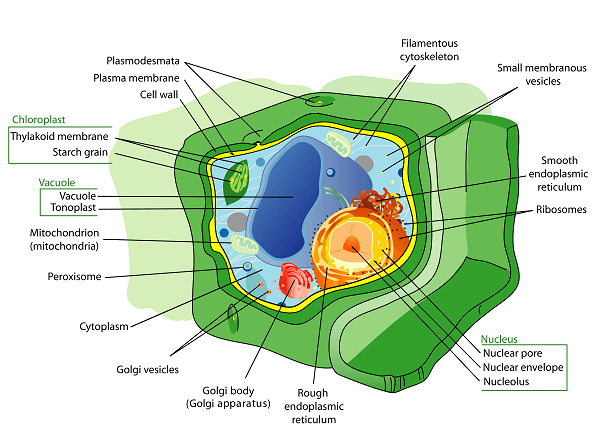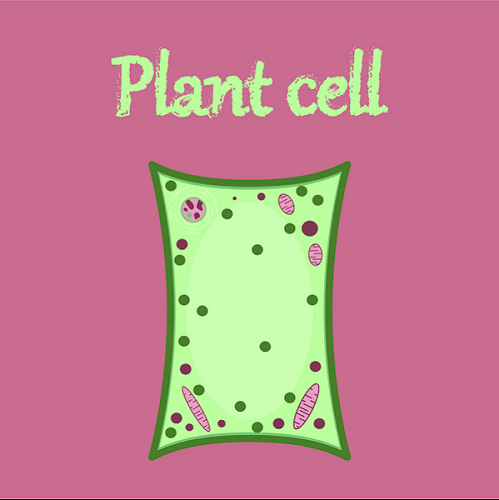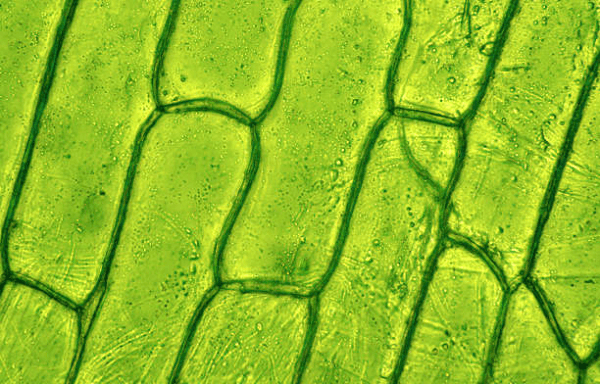Plant Cell DefinitionThe fundamental operational and structural component of a plant is known as a plant cell. It contains various components that are responsible for carrying out different functions. It is the basic unit of all plants and is referred to as eukaryotic (like animal cells). A plant cell is typically enclosed by a cell wall, containing a membrane-bound nucleus and other cell organelles. 
Characteristics of a Plant CellCell WallThe cell wall is one of a plant cell's primary properties due to its versatility and various functions. The outer layer that shields and supports the cell is called the cell wall. The maintenance and protection of the plant's structure and shape are other key functions of the cell wall. ChloroplastsAnother important characteristic of a plant cell is the presence of chloroplasts. Chloroplasts are pigments found in a cell, due to which photosynthesis takes place. They contain chlorophyll, which is a pigment that absorbs light energy and converts it into chemical energy in the form of glucose. VacuoleAnother defining trait of a plant cell is the vacuole. It is a substantial organelle that takes up the majority of the cell's space. Cell sap, a substance containing water, ions, and other compounds, fills the vacuole. The turgor pressure of the cell, which supports the plant, is maintained by the vacuole. NucleusThe nucleus is the fundamental functioning unit of the cell. It contains genetic material, which is organized into chromosomes. A double membrane surrounds the nucleus called the nuclear envelope, which separates it from the cytoplasm. The nucleus is responsible for regulating the cell's activities and for controlling cell division. MitochondriaOrganelles called mitochondria are in charge of generating energy within a cell. They are frequently referred to as the cell's "powerhouse". Enzymes found in mitochondria break down substances such as glucose and others and give off energy through the creation of ATP (Adenosine Triphosphate). For the plant to continue working for its nourishment and functionality, it has to be present. Golgi ApparatusProteins and lipids are modified, sorted, and packaged for transit out of the cell via the Golgi apparatus. The endoplasmic reticulum delivers proteins and lipids to the Golgi apparatus, where they are altered by the addition of sugars, lipids, and other compounds. After that, the altered proteins and lipids are separated and put into vesicles for transportation. PlasmodesmataPlasmodesmata are small channels that connect adjacent plant cells. They enable the transfer of resources between cells, including nourishment and signaling compounds. Plasmodesmata are important for coordinating the activities of different cells in the plant. CytoplasmThe cytoplasm is the gel-like substance that fills the cell. It contains organelles, such as the mitochondria, endoplasmic reticulum, and Golgi apparatus, as well as other molecules, such as proteins, lipids, and carbohydrates. The cytoplasm is responsible for carrying out many of the cell's metabolic processes. LysosomesLysosomes are organelles that mainly play the role of breaking down and recycling unwanted material found in cells. They are equipped with enzymes that are capable of breaking down proteins, lipids, and various other kinds of substances. Lysosomes are important for maintaining the cell's health and preventing the buildup of toxic waste products. Plasma MembraneThe plasma membrane is the layer that surrounds the cell. It regulates the flow of materials throughout the cell. Due to the plasma membrane being a permeable selectively membrane, only specific molecules are capable of passing through it. This is important for maintaining the proper balance of nutrients and managing waste products in the cell. Endoplasmic ReticulumThe endoplasmic reticulum (ER) is a network of membranes that is responsible for transporting proteins and lipids within the cell. Two types of endoplasmic reticulum are found: rough and smooth. The RER (rough endoplasmic reticulum) works in synergy with ribosomes and is responsible for synthesizing proteins. The SER (smooth endoplasmic reticulum) plays the role of synthesizing lipids. PeroxisomesSmall organelles called peroxisomes are in charge of metabolizing fatty and amino acids. Additionally, they aid in the cell's detoxification of harmful substances. These compounds are broken down by enzymes found in peroxisomes, which results in the production of hydrogen peroxide as a byproduct. Other enzymes in the peroxisomes subsequently convert the hydrogen peroxide into water and oxygen. RibosomesRibosomes are responsible for synthesizing proteins. They are composed of RNA (ribonucleic acid) and proteins and are responsible for the translation of the genetic code from the nucleus into functional proteins. Ribosomes can be seen observed either connected to the RER or flowing freely throughout the cytoplasm. CytoskeletonA network of protein filaments called the cytoskeleton gives the cell the required support and structure. It is in charge of preserving the form of the cell, promoting cell division, and assisting in the movement of chemicals and organelles inside the cell. The three distinct kinds of fibers that make up the cytoskeleton are microfilaments, intermediate filaments, and microtubules. Functions of a Plant CellThe building blocks of life within plants are called plant cells. These cells are in charge of performing a variety of tasks required for a plant's growth and development. Since plant cells are eukaryotic in origin, they feature a real nucleus and organelles that are attached to membranes. They play a major role in completing a variety of tasks thanks to their distinctive traits. Some crucial functions include: 
PhotosynthesisOne of the most vital and primary roles of a plant cell is to do photosynthesis. The organelles known as chloroplasts, which are found in plant cells, are a major component for this function to take place. Plants can absorb solar light energy because chlorophyll, a green pigment found in chloroplasts, is present in them. During photosynthesis, chloroplasts use this energy to convert carbon dioxide and water into glucose, a type of sugar that plants consume. Additionally, during this process, oxygen is released into the atmosphere, which is necessary for the survival of many creatures. StorageStarch, proteins, and lipids are among the few examples of compounds that can be stored in plant cells. These compounds are kept in vacuoles, which are organelles present in plant cells. Large membrane-bound organelles called vacuoles can take up to 90% of the space in a plant cell. They are involved in preserving the turgor pressure of the plant, which aids in keeping the plant upright. The detoxification of potentially dangerous chemicals that may enter the plant is another function of vacuoles. Cell DivisionTo support the expansion and advancement of the plant, plant cells typically divide themselves. The DNA (deoxyribonucleic acid) of the cell is reproduced during this phase, and the replicated chromosomes are divided into two daughter cells. The stiff wall that surrounds the plant cell, known as the cell wall, aids in the process of cell division by providing stability and support. The plant's cell wall also helps it keep its form and structure. RespirationAnother crucial role of plant cells is respiration. During this process, glucose is broken down to provide energy that the plant can employ for a variety of tasks. Organelles present in plant cells called mitochondria are where respiration takes place. ATP, a chemical that stores energy, is produced by mitochondria. Following that, the plant uses this energy for a variety of processes, including cell division, growth, movement, and reproduction. TransportAnother prominent function of plant cells is transporting various resources, such as water, minerals, and nutrients. This process is facilitated by the cell membrane, which surrounds each plant cell and is thin and flexible. The cell membrane has a variety of channels and transporters that enable the selective movement of molecules inside the cell. The movement of materials like water and minerals is further aided by specialized structures, such as the root hairs, which improve the root's overall region and absorption. ProtectionPathogens and herbicides are just two examples of the many dangerous substances against which the plant cells fight to protect the plant. Alkaloids, tannins, and phenols, among other substances, are produced by plant cells and act as repellents or toxins to prevent herbivores from feasting on the plant. These substances also help the plant fight off infections by preserving growth and development. Additionally, plant cells are able to recognize and react to a variety of environmental cues, allowing the plant to adapt to shifting environmental factors. Types of Plant CellIn order to maintain a healthy environment, plants are necessary elements of our ecosystem. Plants are distinctive in nature, which is primarily due to their diverse cell structure. Depending on how they are built, how they serve the plant, and where they are found, several types of plant cells can be identified. Some essential types of plant cells include the following: 
Parenchyma CellsThe most prevalent plant cells' kind present in all plant components are parenchyma cells. They usually have thin walls and may be round, elongated, or spherical. They also have a big central vacuole. In addition to food storage and the generation of hormones and enzymes, parenchyma cells also play an integral part in photosynthesis. Additionally, they are essential for the repair and regeneration of plants' damaged tissues. Collenchyma CellsYoung plants' stems and leaves include elongated, unevenly thickened cells called collenchyma. They serve as adaptable scaffolding and give the plant structural support. At maturity, collenchyma cells are living cells and capable of expanding as the plant develops. Sclerenchyma CellsCells called sclerenchyma are responsible for protecting and nourishing the plant. They often die at maturity and have thick walls. Sclerenchyma cells come in two main shapes: fibers and sclereids. The fibers are long, thin strands that provide tremendous structural integrity for the plant. Sclereids, on the other hand, are short and asymmetrical in shape and protect the plant by producing a hard outer shell. Epidermal CellsThe epidermal cells that cover a plant's exterior shield it from critical elements, including wind, rain, and high temperatures. They are elongated, flat, and devoid of chloroplasts. The cuticle, a waxy coating produced by epidermal cells, aids in preventing water loss and shields the plant from diseases. Guard CellsThe epidermis of leaves and stems contains dedicated cells called guard cells. They have a kidney-like form and are located around the stomata, which are tiny pores on the surface of the plant that facilitate gas exchange. Guard cells control the stomata's opening and shutting, which aids in controlling the plant's water balance and gas exchange at regular intervals. TrichomesTrichomes are found on the surface of leaves, stems, and flowers, and they resemble hairs. They can have one or more cells and can be of different sizes and forms. Trichomes are essential for defending the plant from infections, insects, and herbivores. By absorbing sunlight and lowering wind speed, they also aid in preventing water loss. Xylem CellsWater and minerals are moved from the roots to the rest of the plant through xylem cells. They are sturdy and long-lasting because of their cylindrical shape, thick lignin walls, and other characteristics. Tracheid and vessel elements are two different types of xylem cells. Phloem CellsOnly phloem cells can carry nutrients and other organic materials from the leaves to the rest of the plant. They have thin walls and cylindrical, long forms. Phloem cells come in several forms, including sieve cells and sieve tube components. Higher plants have components of sieve tubes, while lower plants have sieve cells. Food and biological products can be transported efficiently in long tubes consisting of sieve tube components. Root Hair CellsPlant roots include specialized cells known as root hair cells. They are stretched out and have thin walls, which enable the absorption of water and minerals from the soil. Root hair cells expand the root system's surface area, which improves the plant's ability to absorb nutrients. Meristematic CellsPlants' undifferentiated cells, known as meristematic cells, are typically found in plant growth zones. Meristematic cells quickly divide, and the daughter cells of these divisions develop into different kinds of plant cells. Apical and lateral meristems are the two different types of meristematic cells. ConclusionIn conclusion, the plant cell is the elementary component of every plant and has a variety of organelles that work together to ensure the proper functioning of the cell. The cell wall provides support and protection, while the plasma membrane regulates the flow of materials in and out of the cell. The nucleus controls the cell's activities, while the cytoplasm provides a medium for chemical reactions to occur. The chloroplasts carry out photosynthesis, while the mitochondria produce energy. The endoplasmic reticulum transports proteins and lipids, and the Golgi apparatus modifies and packages them for transport. The vacuole stores water and nutrients, while peroxisomes break down fatty acids and amino acids. Ribosomes synthesize proteins, and the cytoskeleton provides structure and support. Finally, plasmodesmata connect adjacent plant cells, allowing for the exchange of molecules and information.
Next TopicScalar Quantity Definition
|
 For Videos Join Our Youtube Channel: Join Now
For Videos Join Our Youtube Channel: Join Now
Feedback
- Send your Feedback to [email protected]
Help Others, Please Share









